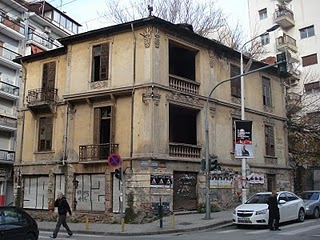This bill proposes, through a fast track process, the taking over of building management for 50 years by municipalities, municipal companies, Public Legal Entities (NPDD) or even private companies and carriers. Under conditions, derelict property may even come into the ownership of a municipality.
Preserved buildings, newer monuments
According to the proposed regulations, for a property to be classified as abandoned it must firstly be uninhabited or not used for the exercise of a legal activity for 15 years and secondly not have an active connection with utility networks in the last 10 years.
The final text of the draft law available to “To Vima” describes the process through which abandoned properties can ( private, public or unknown owner) to pass to municipalities. They will have the possibility to transfer the management to NPDD or Legal Entities of Private Law (NPID) with experience in the management and exploitation of real estate, such as building management companies, investment funds, etc.
However, the municipalities will be able to manage them themselves, by establishing or participating in companies. Especially for listed buildings, newer monuments or properties with a built-up area of more than 5,000 m2, the construction work for their restoration by the administrator who will undertake them, they must be completed within five years. Otherwise, the owner of the property can again claim its management, without even being charged the costs of restoration until then.
For the rest of the property categories, there is no provide a specific time horizon for the restoration work. Movable objects that may be found in a building will be removed and kept for two years. If the municipality does not acquire the entire abandoned building, it is possible to assign technical restoration works – without an auction or tender – to a company that has already been selected by the other owners, if they have an ownership percentage of more than 50%.
How does the management pass in the municipality
Prerequisite for the start of the restoration works is the issuance of a decision by the Single Member Court of First Instance, following a request from the municipality. There must have been a decision by the Economic Committee of the municipality to classify the property as abandoned and its notification to the alleged owner of the property, or to the small owner and the usufructuary.
It should also be posted on the council shop and property, posted on the council website and published in newspapers. If there is a secured loan, a notice will also be sent to the banks, which can object if a foreclosure procedure has already been initiated and an auction is imminent.
Otherwise, the burdens are assumed by the new administrator and indeed the property is forbidden to be auctioned before the expiry of the management concession time.
With the notifications, the owner will be called to declare in writing to the municipality within 30 days if he consents to the transfer of the management of his property to the management body, or if he intends to reuse the property himself. If he consents, then no legal action will be taken. Otherwise, he will have to submit his objections, which will be included in the case file at the Court. An appeal against the court decision is allowed within 15 days. In the event that he declares that he will reuse the property himself, but does not do so within eight months, then the municipality starts the procedure through the Court of First Instance.
However, to secure ownership, the original owner never loses the right to claim the management of his property. However, in order to be reimbursed, the costs that have already been incurred will be attributed to him and he is obliged to comply with agreements that the manager has made up to that moment.
How ownership passes to the municipality
Abandoned property can even come into the ownership of a municipality, either voluntarily, by directly purchasing it from the owner in its market value, either by accident, by use, or after the lapse of seven years from the court decision to transfer management to the municipality, with a financial consideration.
The decision of Court can be challenged within seven years from its issuance. However, in order to safeguard investment, even if ownership is returned to the original owner, any lease or concession of the property by the municipality continues on the same terms until it expires.
Utilization and management of buildings
According to information, in the final text of the legislative proposal, managers of abandoned buildings are defined as the municipalities, within whose administrative boundaries the properties in question fall, or other entities to which each municipal authority may assign management and in particular a limited liability company of the municipality, or even a third party legal entity of public or private law with experience in management and utilization of properties, such as e.g. Real Estate companies, etc.
For the management or utilization of abandoned real estate, municipalities will be able to establish companies or participate in companies in derogation of the current legislation . In addition, they will be given the possibility to establish a Municipal Land Bank (independently or in collaboration with other professional or social bodies), to keep a register of properties, especially abandoned, vacant or unknown owners.
The properties will be entered in the Registry after the transfer to the Mortgage Registry or the Land Registry of the irrevocable decision of the Court for the transfer of the management of the property to the municipality. The conditions and procedures for the establishment and operation of the Land Bank, the ways of exploiting the properties and disposing of the income from it will be specified, after the passing of the bill, by a decision of the Ministers of Finance and Interior.
It will vest in the trustee for 50 years
Under the proposed arrangements, an abandoned property will be able to vests in the Administrator (municipality or other entity) for up to 50 years from the issuance of the relevant decision of the Single-Member Court of First Instance.
The relevant application of the municipality to the Court of First Instance will there has been a decision by the Financial Committee to classify the property as abandoned and inform the one who manages the property (principal, public, small owner, usufructuary or lender in rem). In the event that there is a dispute regarding the transfer of the management of the property to the municipality, the municipality will have to reuse the property itself. If after the lapse of eight months it is established, following an autopsy, that there has been no change, the procedure is initiated by the municipality.
An abandoned property will not be able to go into management of a municipality if foreclosure proceedings have already been initiated and an auction is imminent. The management of the property will begin after the court decision has become final and it has been transferred to the competent Mortgage Registry or registered in the relevant Land Registry.
The building restoration works will they must be completed within four years – or five years in the case of listed buildings, newer monuments, properties with a built-up area of more than 5,000 m2 – from the assumption of management by the municipality or another body. Otherwise, the owner of the property can claim the return of the property, without being charged the construction costs until then.
In the case of co-ownership, it will be possible to assign technicians rehabilitation projects of an abandoned building without an auction or competition by the municipality, to a company already selected by the other owners, if they have an ownership percentage of more than 50%.
In general, the proposed regulations follow the… well-trodden path, i.e. the corresponding efforts that had preceded, but never reached the Parliament, such as the draft laws that had been presented in 2014 during the ministry of Yiannis Maniatis, or later by the then Deputy Minister of Environment George Dimaras in 2019 and Dimitris Oikonomou in 2020.
Return of income under conditions
After half a century has passed, the management will revert to its owner, i.e. to the one who owns more than 60% of the property and will be awarded the income from the property’s exploitation, after deducting certified restoration and reuse costs, municipal taxes and fees owed by the owner before the management of the property fell to the municipality, the amount corresponding to 20% of the total of all these funds as an administrative expense, as well as any encumbrances that have been served.
However, if the deductions exceed the income or if there is no income, the property is reinstated if the building owner pays the difference in costs or provides an equivalent guarantee. Otherwise, the municipality or the entity that managed it will be able, in order to secure its claim, to register a pre-notification on the property. It is noteworthy the reference in the draft law that “the Manager is not liable to the owner for the management of the property or the interventions thereon”.
Terms and conditions of characterization
A building that is not used or presumed to be used by its owner or other legal owner will be classified as abandoned. It must not, within the last decade, have an active connection to public utility networks, not be inhabited or used for a legal activity, nor be legally owned. In addition, one of the following conditions must be met:
- The external appearance and the surrounding area (if any) present an image of disrepair or have a hazard protocol has been issued.
- To be a source of contamination or delinquency and to threaten public health or safety.
- To be in need of major repairs.
- To not have been issued a permit of repairs during the last decade.
- Be under construction based on a building permit and remain unfinished up to the plastering stage in the last 15 years.
- Not have been declared in the Land Registry.
- li>
- Not having submitted an inventory declaration (E9).
The last two conditions do not apply to State properties. In cases where there is a court order that binds the property or when its use is prohibited for the purposes of a criminal investigation, then it is not considered abandoned.






